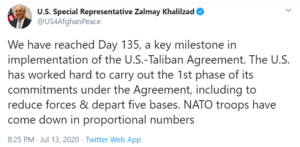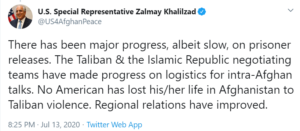By Kent R. Kroeger (Source: NuQum.com; July 22, 2020)
The New York Times broke a bombshell story on June 26th with this headline:
Russia Secretly Offered Afghan Militants Bounties to Kill U.S. Troops, Intelligence Says.
No, the bombshell information is not that Russians might be paying our adversaries to kill our soldiers. That’s been going on for close to 75 years now. And, truth be told, the U.S. does the same to Russia. The CIA’s Operation Cyclone during the Russian occupation of Afghanistan (1979 to 1989) comes to mind, but sometimes the U.S. just kills Russians directly, as we did in Syria. No middleman or bounty required. Either way it’s called statecraft, and its a dirty business.
Rather, the bombshell news is that the CIA is leaking classified intelligence–probably illegally, as only the President and those he delegates have the legal authority to declassify such information, per Executive Order 12356–in an apparent effort to undermine the Trump administration’s policies in Afghanistan, if not undermine the administration’s overall ability to govern.
If this were done in one of Donald Trump’s shithole countries, we’d call this type of government intelligence activity part of a coup effort. As it was done in the U.S. during the Trump administration, its called the ‘nightly news.’
Whether coincidental or not, the Times story is coming out at the very moment the Trump administration moves forward in brokering a peace deal with the Taliban and the current Afghan government in an effort to end our 19-year war in Afghanistan, the longest in U.S. history.
On July 13th, chief U.S. negotiator and peace envoy Zalmay Khalilzad tweeted:
In a good faith move, the Trump administration recently dropped U.S. troop numbers in Afghanistan from 12,000 to 8,600 and closed five military bases.
While the Taliban has increased their military activity against the Afghan government in recent months–most likely an effort establish their leverage at the negotiating table–they have not targeted U.S. troops, despite such lazy inferences repeatedly drawn in the U.S. mainstream media from the thinly-sourced Times ‘bounties’ story.
The last U.S. troop deaths in Afghanistan due to hostile activity were on February 8th, from a Green on Blue attack (i.e., an attack by Afghan National Security Forces or an Afghan contractor employed by the International Security Assistance Force–ISAF). These U.S. combat deaths occurred three weeks prior to the signing of the U.S.-Taliban Peace Deal on February 29th.
If there have been Russian-paid bounties on the lives of U.S. soldiers, they have had no substantive impact on the Afghan conflict.
The Enemy of My Enemy is My Friend
Growing tensions between the U.S. and Russia during the Obama administration and continuing under Trump has led Russia to pursue closer economic and security ties with the Taliban in anticipation of a potential U.S./NATO as early as next year. This is old news.
Reports surfaced in 2016 that the Russians were providing weapons to the Taliban to fight ISAF (US and NATO)–weapons used to kill American soldiers. This happened during the Obama administration.
By 2017, U.S. military leaders were openly calling out the Russians for providing military support to the Taliban.
It is in this context the Times reported in late June that, according to an anonymous U.S. intelligence source, the Russians had issued “bounties” to encourage Taliban commanders to target U.S. troops. Days later it would be reported that some of the intelligence used to support the “bounty” conclusion came from financial records showing possible payments to the Taliban by the Russians.
Underlying this reporting–based entirely on anonymous intelligence sources–is the implicit narrative that the Trump administration “ignored” the intelligence, thereby becoming complicit with the Russians and Taliban in the killing of U.S. troops.
The anti-Trump outrage brigade went full speed ahead with the ‘bounty’ story and its innuendo of treason, despite at least one U.S. official working closely on Afghanistan admitted it “is not a big step to see that they (the Russians) were also paying a ‘bounty’ to Taliban commanders” for targeting U.S. soldiers.
Some independent journalists such as Max Blumenthal promptly challenged the dubiousness of the Times ‘bounty’ story—Why would the Russians need to pay the Taliban to do something they already do quite willingly?–claiming that the intelligence leak to the Times possibly represents a U.S. intelligence/military community effort to prolong the U.S. occupation of Afghanistan by sabotaging the U.S.-Taliban peace talks.
Putting aside for the moment any bureaucratic rebellion aimed at keeping the U.S. in the longest war in its history, the validity of the ‘bounty’ is most likely described by one of three explanations:
Explanation (1) The ‘bounty’ story is true and U.S. intelligence caught the Russians red-handed (no outdated pun intended),
Explanation (2) the story is not true and was built on circumstantial evidence, resulting in sincere but flawed inferences and conclusions (probably fitting a preexisting narrative already circulating within anti-Trump forces inside the U.S. government), (3)
Explanation (3) this story is not true and was a willful use of disinformation (or the reckless exaggeration of legitimate intelligence) meant solely to discredit the Trump administration.
With the recent news that some intelligence officials had only “medium confidence” in the Russian “bounty” conclusion—thereby explaining the Trump administration’s decision not to overreact to that intelligence report—I would assign the general probabilities for the three ‘bounty” story explanations as follows: Explanation 1 could be true, Explanation 2 is more likely to be true, and Explanation 3 cannot be ruled out.
Regardless of the ‘bounty’ stories truth, there is legitimate news–if still circumstantial–contained within the media frenzy aimed at further tainting the integrity and credibility of the Trump administration.
First, by refusing to foolishly ratchet up tensions with the Russians and Taliban over the ‘bounty’ story, the Trump administration is showing remarkable focus and leadership in trying to hammer out a viable and lasting peace with the Taliban. Though they may still fail—and, frankly, it doesn’t help that many Volvo Democrats and anti-Trump Republicans are actively working to malign the administration’s Afghan peace efforts—the Trump administration’s intentions do appear authentic.
Second, the Taliban’s is also showing exceptional internal discipline in ending their attacks on ISAF troops since February in an apparent good-faith effort to honor the U.S.-Taliban Peace Accord (the Afghan National forces have not been as fortunate). Whether the ‘bounty’ story is true or not, there is no substantive evidence in ISAF fatality data suggesting the Taliban has systematically altered its military tactics or strategy because of a Russian financial incentive program.
Finally, the most troubling aspect of the Times ‘bounty’ story is that the U.S. intelligence community is freely leaking classified information (without apparent consequence despite such actions most likely being illegal) with the clear intent of undermining the Trump administration. That our intelligence community for over three years now has never been held accountable for violating one of this community’s strictest legal boundaries—the authorization to collect and analyze only foreign intelligence in service to the executive branch—should alarm every American. By leaking to the news media an accusation that the Trump administration is not acting on classified intelligence is, by definition, a form of spying on the Trump administration.
The “bounty’ story leaker cannot justify his or her actions as a ‘whistleblower’ as the person did not go through the authorized ‘whistleblower’ process. And any justification of the leaker’s actions on the grounds that he or she is exposing the Trump administration’s gross negligence with intelligence ignores the fact that administrations have been ignoring military intelligence since at least 1812 when the James Madison administration ignored military intelligence reports saying the British were planning to invade Washington. Madison’s administration didn’t act on the intelligence until British troops were a mere 16 miles from the Capital.
Even if mostly true, the Times ‘bounty’ story is non-news posing as substantive news. It is a pattern we saw worked with ruthless precision during Russiagate coverage in which non-news stories–such as incoming National Security Adviser Michael Flynn talking privately to the Russian Ambassador to the U.S.–become “blockbuster” exclusives confirming Trump was a Vladimir Putin puppet and signaling the imminent end of the Trump presidency. None of that was ever true and you can be forgiven if you are rolling your eyes at the ‘bounty’ story as well.
In a free society with a free press, journalists have every right to uncover stories like the ‘bounty’ story. But it is dangerous for the public to turn a blind eye to the U.S. bureaucratic state using journalists to facilitate domestic political attacks using information of unknown veracity. Wikileak’s Julian Assange sits in a UK prison because he published classified information about U.S. military actions in Iraq—not one word of which Wikileaks has ever had to retract for being a falsehood.
The laundry list of falsehoods, inaccuracies, smears, deceptions and baseless inferences published by the U.S. news media during Russiagate should be used to paper the walls of every journalism school in the country.
Journalism is all but dead in the U.S. and Donald Trump isn’t to blame—nor are the Russians.
- K.R.K.
Send comments to: kroeger98@yahoo.com or tweet me at: @KRobertKroeger1


